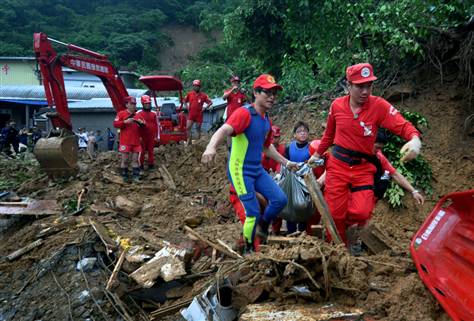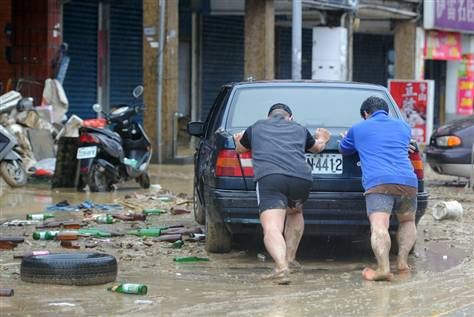
Six other people were missing and a number of vehicles were trapped on a highway as Typhoon Megi swept toward southern China, where landfall is expected late Friday or Saturday.
The storm earlier killed 26 people and damaged homes and crops in the Philippines.
Megi dumped a record 45 inches of rain in Taiwan's Ilan county over 48 hours. It had winds of 90 mph and was about 275 miles southeast of Hong Kong on Friday evening local time, the Hong Kong Observatory said.
The seven people who died were at the White Cloud Temple in Suao city along the eastern coast when it was engulfed by the mudslide, Taiwanese cable TV stations reported.
Rescuers were using bulldozers to try to dig out six other people, Ilan county chief Lin Tsong-hsien said.
Two buses carrying Chinese tourists were on a six-mile stretch of a coastal highway in Ilan that was hit by at least seven rockslides Thursday night, Premier Wu Den-yih said.
Nineteen people on one bus were rescued - five with light to moderate injuries - but the Taiwanese driver and the Chinese tour guide were still missing, Wu said.
There had been no contact with the 19 tourists aboard the other bus, he said.
TV news reported a 500-yard stretch of the highway had collapsed. The rockslides trapped about 30 vans, buses and cars, officials said.

The storm dumped heavy rains throughout Taiwan, but Ilan, about 90 miles southeast of Taipei, was the hardest hit.
Authorities said more than 2,500 residents had been evacuated. Broad swaths of farmland in the county were under many feet of water.
Earlier this week, Megi killed more than two dozen people and damaged thousands of homes in the northern Philippines.
The storm also forced 55,000 Filipinos from their homes and caused about $175 million in damage to infrastructure and crops, disaster officials said.
Megi was expected to hit China's southern Guangdong and Fujian provinces between Friday night and Saturday, meteorologists said.
'Super strong' storm
In Fujian, authorities said 161,800 people were evacuated to safer places.
An official in Guangdong's Shantou city said fishermen were told to return to ports and authorities designated some 200 buildings in the city as emergency shelters.
"This kind of strong typhoon is very rare for this season in Shantou. We are treating it as a 'super strong typhoon' and making our preparations accordingly," said a relief official who only gave his surname, Chen.
A string of ports and oil terminals in southern China had closed operations on Thursday as marine authorities said the typhoon could generate a huge and destructive "50-year storm surge" along the China coastline.
Hong Kong's main port remained partially shut, with leading port operator Hongkong International Terminals halting the processing of containers, the company said.
Megi has got weaker and it was expected to hit China's Fujian province as a category 1 typhoon - down from a 3 on a 1-5 severity scale - and then fade to a tropical storm, Forecasting service Tropical Storm Risk said.
"It's showing signs of weakening," said Lee Tsz-cheung, a senior scientific officer with the Hong Kong Observatory. "We expect the intensity will gradually decrease until it makes landfall and decreases further."
While Megi bypassed Vietnam, the country's central region was pummeled by about four-and-a-half feet of rain over the past week, inundating large swaths of land, submerging nearly 280,000 houses and forcing more than 170,000 villagers from their homes.
The death toll from severe flooding in four central Vietnamese provinces climbed to 75, including 14 victims from a bus swept off a road by strong currents, with six passengers still missing, disaster officials said Friday.
Meanwhile, another storm, Cyclone Giri, was spinning in the Bay of Bengal and likely to make landfall Saturday in western Myanmar.
The storm was expected to hit with winds of 75 mph and a tidal surge as high as 12 feet. In 2008, Cyclone Nargis killed 130,000 people in Myanmar.
The Associated Press and Reuters contributed to this report.



Reader Comments
to our Newsletter